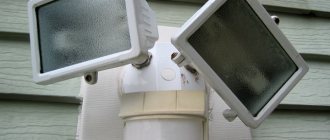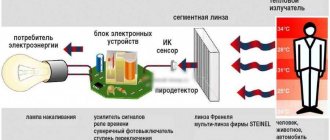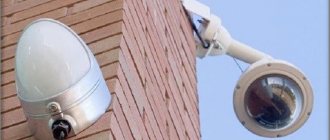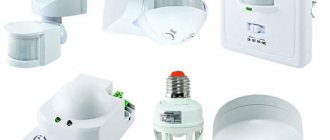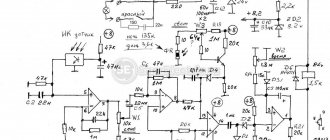Last updated January 2, 2022
A motion sensor is a sensitive device that detects the movement of living (and other) objects in a room, and then sends a signal to the appropriate equipment. Motion sensors were among the first to appear in security alarm systems - where they helped to detect the entry of an unauthorized person into a room or territory, and then turned on an alert. Today, the scope of application of these devices has expanded significantly and has become actively used in private housing for the most peaceful purposes. The introduction of motion sensors is especially active in smart home systems.
Types of motion sensors
There are many classifications of motion-recording devices, but the main principle remains the gradation principle according to the type of device. In order to sense movement, the device needs to register changes in certain parameters. This can be realized in various ways - with the help of microwaves, ultrasonic vibrations and other physical phenomena. Such sensors are active - they constantly emit a stream of radiation, and after the appearance of a moving body they register reflections of wave oscillations.
Expert opinion
Yakovlev Alexey Sergeevich
Electrician with 20 years of experience and extensive experience
In residential premises, including for integration with the Smart Home system, infrared sensors are most often used. They have a number of advantages that make them optimal for performing tasks.
Operating principle of an infrared motion sensor
Heat emitted by living things is radiation in the infrared spectrum. Considering that warm-blooded animals have a body temperature of 30 to 40 ° C, the strength of these rays is quite high and can be recorded by sensitive equipment. Inside the infrared sensor there is usually a system of lenses (in cheaper ones - one segment), which concentrate thermal radiation on a special element - a pyrodetector.
When a certain threshold is exceeded (usually it is set during installation and is largely determined by the sensitivity of the device), the pyroelectric element is triggered and sends a signal to associated devices.
On a note. Heat is emitted not only by living beings, but also by an air conditioner that operates for heating and a heated floor system. Therefore, motion sensors are designed in such a way that they are triggered by an abrupt change - that is, the appearance of a person in the field of view. True, if the sun in the window “shoots” rays into the lens of the infrared sensor, the device will work. That is why it is not placed opposite the window and is always hung from the ceiling.
Device structure
The simplest IR sensor consists of two small Fresnel lenses - complex composite structures of many prismatic facets forming a convex bowl. They collect information about heat waves from a specific area and transmit it to sensitive sensors connected to them. Usually the data obtained by both lenses is approximately the same - this means that there is no movement. If a significant difference appears between them, then a person or other object emitting a large amount of heat has appeared in the “field of view” of the detector.
In reality, a device with two lenses would be impractical because the sensitivity would be too low. In modern models of sensors, several dozen of them are installed - from 20 to 60.
The exact designs of motion detectors vary from manufacturer to manufacturer, but the approximate design is similar. The device consists of the following elements:
- Optical system. It includes many lenses, which, depending on the device model, can be of different shapes and sizes necessary to cover the desired area of space. Separated from other elements of the system by a hermetically sealed chamber to avoid exposure to the heat they generate. Can control one or more planes of space, and also do it in a circle or along a beam.
- Sensor. Most often it is a pyroelectric element, but sometimes there are models with thermocouples, microbolometers and semiconductors. It records the readings received from the optical system, and if inhomogeneity occurs in them, it sends a signal to the required device.
- Signal processing block. Analyzes the length, amplitude and shape of infrared interference to prevent false alarms. They can be caused by factors such as sunlight, vibration, electromagnetic waves, animal movement, heat from appliances or electronics, and even moving air currents. Simpler processing units simply “weed out” signals that are too weak, while complex versions of the devices analyze the duration and frequency of inhomogeneities and, based on them, determine whether it is interference or not.
It is worth noting that all the principle of operation of a motion sensor is to obtain information about the presence of a person in its coverage area. Therefore, it is almost never used without connecting to other devices that use this information. They can be the following devices:
- alarm system;
- security systems that send a notification to the sensor owner and security service;
- lamps, pool lighting and other lighting devices that turn on or off depending on the presence of people in their area;
- climate control technology that changes its parameters according to the same principle.
Most often, IR sensors are sold not on their own, but in combination with security systems or other equipment.
But there are exceptions - then you will have to connect and configure the devices yourself. For this purpose, the user will be given access to his personal account on the website and in the mobile application, from where he will be able to set parameters for the interaction of devices.
What are the advantages of an infrared sensor
A device that records movement by thermal radiation has significant pros and cons:
pros
Low current consumption. Unlike active sensors that emit ultrasound or microwaves, the infrared sensor belongs to the family of passive sensors; power consumption is very low, which allows it to be installed autonomously, powered by a battery.
There are no false alarms for moving objects other than warm-blooded ones (for example, a robot vacuum cleaner, a swaying curtain by a window).
It can easily be connected to a smart home gateway (hub) or directly connected to a lighting device via an electromagnetic relay.
Minuses
Not too large coverage area (usually up to 10 meters).
Failure to operate at too high or low temperatures.
But it is precisely these shortcomings that are insignificant in indoor use conditions, because there is no frost in the apartment and house, and people do not wear fur coats. As for the coverage area, it is always limited by the dimensions of the room.
These features allow us to consider infrared sensors as the optimal tool for automating smart home scenarios.
Battery Life Calculation
Calculating the battery life of a development board is complicated by the many different applications and operating conditions for this type of sensor. The approach to solving this problem is based on calculating the average value for two plausible but different operating conditions and one worst-case use case for the sensor. These conditions for using the sensor are as follows:
- Option 1 (worst case) - 10 movements per hour every hour for the entire battery life. Each movement of an object in the field of view of the sensor is a separate event, that is, it causes an interruption and, upon completion of the timer, the MK returns to sleep mode until the next interrupt occurs.
- option 2 - office space, 14 hours of sleep mode and 10 hours of continuous movement, in which the timer does not have time to reset before the next activation.
- option 3 - a room with an intermittent pattern of movement during working hours, 14 hours of sleep mode and 10 movements every hour for 10 hours, and each movement, as in case 1, is a separate event.
One way to optimize battery life in a given development board is the duration of the active timer mode. The default value in the program is one minute. Since this parameter can be easily changed, to demonstrate the possibility of increasing battery life, cases 1 and 3 were rescaled to a timer duration of 30 s.
The formula for calculating battery life is as follows:
Where
The reduction factor in the formula takes into account the self-discharge of the battery. Analysis of the calculation results shows that the planned average battery life in this development board with the timer set to 1 minute is 11.22 years. Recalculating the service life for cases 1 and 3 with the timer set to 30 s gives values of 9.9 and 11.99 years, respectively. The average battery life with the timer set to 30 seconds is therefore 11.34 years. For the worst case scenario, setting the timer to 17 seconds or less increases battery life to at least 10 years.
Application area
A motion sensor is a universal device that can be used in a wide variety of household areas. The industrial application of such devices is even wider, but this is a separate topic.
Home lighting automation
The most common scenario used in residential premises - apartments and houses. When a motion detector is triggered, the sensor sends a signal to the controller, which turns on the lighting in the corresponding room. This can be either local or general light, as well as all sorts of additional sources: LED strips, bedside area lighting, and more.
The use of lighting sensors to automate turning lights on and off in rooms allows you to save up to 40% on electricity.
Together with the installation of infrared sensors, it is possible to resolve the situation when the owners leave the room, forgetting to turn off the light in it.
Security functions
This use of thermal sensing equipment was a first and continues to produce good results. Using a motion sensor you can:
- Organize the sending of a push message to the owner’s smartphone (the function is activated when leaving the apartment).
- Program the activation of the alarm, including sending an alarm signal to the security post.
- View the time of arrival of family members in the “log” section, where the history of sensor activations is kept.
Climate control
This combination is used less frequently than with lighting, but it also occurs. Based on the sensor signal, devices that maintain the parameters of cold and heat in the apartment can be turned on: batteries or a heated floor system, air conditioning, fan, humidifier and other devices. Thus, maximum energy expenditure occurs only at the right time, and not constantly.
It is worth noting that the widespread use of infrared motion sensors in the field of home climate control is hampered by the phenomenon of thermal inertia. In order to fully warm up a room, it takes time - and this must be done in advance, before entering it. As a result, a comfortable temperature is not achieved immediately, but when this is often not necessary, the person goes to another place.
Functional characteristics
Motion detector sensitivity
The sensitivity of the sensor was measured for several types of motion detectors with different parameters of the power circuits and two active filter gains Av. Table 3 provides a summary of the results of these measurements. The highlighted cell in this table shows the motion detector sensitivity for the configuration implemented in the development board of this TI design.
Table 3. Sensitivity of IR motion detectors in various operating modes
| Name | Current consumption in sleep mode, nA | Vout, V DC | Maximum detection range at Av = 90 dB, m | Maximum detection range at Av = 70 dB, m |
| RS = 2.2 MOhm, RD = 1 MOhm | ||||
| IRS-B210ST01 | 365 | 0,78 | 6,1 | 1,83 |
| IRS-B340ST02 | 355 | 0,764 | 7,62 | 2,44 |
| IRA-E700ST0 | 500 | 1,093 | 3,66 | 1,37 |
| IRA-E712ST3 | 555 | 1,204 | 3,96 | 1,52 |
| RS = 1.3 MOhm, RD = 620 kOhm | ||||
| IRS-B210ST01 | 594 | 0,77 | > 9,14 | 1,98 |
| IRS-B340ST02 | 572 | 0,744 | 8,23 | 2,44 |
| IRA-E700ST0 | 838 | 1,085 | 4,57 | 1,52 |
| IRA-E712ST3 | 920 | 1,178 | 5,18 | 2,29 |
Wireless range
The radio transmission range, measured in a typical office environment with partial line of sight overlap, was 220 m. The radio signal level at the maximum distance, measured using the CC1111 packet analyzer, was less than - 100 dBm?. Despite the fact that the obtained range, given the small size of the antenna on the printed circuit board, can be considered an excellent result, there are ways to increase this distance. The first of them is based on the use of a whip antenna, which has a higher gain compared to a printed circuit board antenna. Another way is to increase the power of the CC1310 transmitter to the maximum level by slightly increasing the current consumption during data transmission.
Criteria for selecting an infrared motion sensor
All devices that are on the market are very similar to each other, however, they also have enough differences that will seriously affect the practice of their use in the smart home system.
Nutrition
All sensors are divided into wired and wireless. The former receive power via a cable, the latter require a battery or even a regular battery for power, which also lasts a long time due to its low power consumption.
On a note. In household wireless sensors for the smart home system, a CR2032 lithium battery is most often used. It lasts on average for one and a half to two years.
Each type has its own advantages: wired devices operate from a constant power supply, but wireless ones are easier to place - there is no need to lay a low-current cable.
Data transfer
Here everything comes down to wires again. Sensors can be connected to the gateway directly, through a system of cables hidden behind suspended ceilings, baseboards or in grooves. Wireless devices connect to the hub via Wi-Fi or Bluetooth. For example, the Aqara system uses a special Zigbee protocol.
Viewing angle
It usually depends on the location of the sensor. Devices that are mounted on the wall usually cover 150 – 180°. If we talk about the ceiling sensor, it has an all-round view and registers any movement in the room within its range.
Radius of action
That is, the range of the device. For household infrared sensors, it rarely exceeds 7–9 meters. However, more is usually not necessary. For outdoor installation, you should choose more powerful and sensitive models with a range of up to 15 m.
Features of accommodation
Most often, sensors are placed either on walls (or any other vertical surfaces) or on the ceiling. The first models have a lens hemisphere in the front part, the second - at the bottom. Sometimes sensors are placed in a corner to achieve optimal coverage.
Some models come with a stand included. This configuration makes both placement options possible.
Photocell equipped
Thanks to an additional photo sensor, the device recognizes the level of illumination and does not turn on the light during the day when it is not required.
Outdated touch detection technology - SAW
The bonus of this article is short information about which devices with which interactive screens we do not recommend using, due to their unreliability.
SAW – surface acoustic waves
. Remember those same Qiwi terminals that constantly glitched, did not respond to touches or responded incorrectly? So, these are the screens that were used in these information kiosks. Why did this happen? The answer lies in technology. These screens cannot be used outdoors; as soon as moisture gets on the surface (for example, wipe with a damp cloth), surface acoustic waves are disrupted, causing the device to fail and be difficult to repair, often requiring an expensive replacement.
Therefore, please review the hardware specifications carefully before purchasing interactive products.
Popular motion sensors
Infrared motion sensors today can be purchased both in electrical stores and on various online trading platforms.
REV DDV-3
A small sensor in element format for self-assembly and connection of a motion response system. Designed for hidden installation. Compact, simple, but the range is small. Has a built-in shutdown timer with regulator.
IEK LDD10-009-1100-001
A powerful sensor with a range of 12 m, allowing it to be placed outdoors. Moisture protection is only nominal, against splashes (class IP44), so placement under a canopy is recommended. With fairly large sizes, the regulators are very small - you will need tweezers to adjust them.
IEK LDD11-024-1100-001
Another device from IEK, this time of the hemispherical type. Both wall and ceiling installation are allowed. The switches are located under the cover. It has a built-in relay, but the click is a moderately quiet sound.
REV 15283 5
A classic wall sensor with a range of 12 m, it is intended for placement in long corridors, as well as in areas of private houses. The device “lacks stars from the sky,” but honestly performs all functions. The only disappointment is the small viewing angle – 110°.
TDM ELECTRIC SQ0324-0016
An original solution - the sensor is combined with an E27 socket, screwed into a standard socket and serves as a kind of adapter for the light bulb it controls. It can be a good solution if you need to install only one light source that turns on when moving.
HIPER IoT M1
Good design, excellent sensitivity, convenience and versatility of installation - everything for a smart home system. The communication protocol with the gateway is Wi-Fi, via a router. The disadvantages include a rather long response time, as well as occasional malfunctions that require a reboot.
Aqara Motion Sensor
The sensor interfaces not only with the proprietary Aqara gateway, but also with Apple Homekit, as well as the general Xiaomi MiHome. Thanks to the ball foot, it can be placed anywhere. The software's scripting implementation makes it one of the best options.
Question answer
Will the sensor respond to pets?
For small ones - no, but for large ones, over 20 kg - yes. To prevent this from happening, you should reduce the sensitivity.
How is a motion sensor different from a presence sensor?
There are no presence sensors as such - it's just a marketing name for sensitive infrared devices. They read even the slightest movement, creating the illusion of presence recognition.
How to make sure that the light does not stay on for a long time after being turned on by the sensor, for example, on the stairs?
To do this, you need to set a shorter delay - for example, half a minute - this is quite enough to get up.

